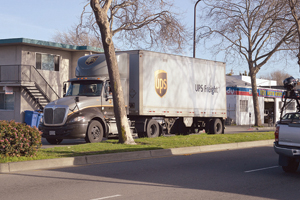Quarterly Earnings Drop 1.9% at UPS on Rising Costs for Holiday Deliveries

This story appears in the Feb. 9 print edition of Transport Topics.
UPS Inc. last week said fourth-quarter earnings fell 1.9% from a year earlier because of higher costs to deliver holiday packages, an issue that company officials insisted will be fixed.
Earnings excluding one-time charges were $1.14 billion, or $1.25 per share. Higher costs lowered U.S. package profit before interest and taxes by 5.3%, despite a 7.5% jump in revenue to $10 billion. UPS identified $200 million of added costs — such as overtime — to correct a 2013 capacity shortfall that also hurt profits.
Companywide revenue rose 6.1% to $15.9 billion. Profit slipped less than 1% at the international business while revenue increased 1.6% to $3.43 billion.
Strong revenue and profit growth at UPS Freight helped to improve results 4.7% at the Supply Chain and Freight unit. “It was important to fortify the trust of customers” through steps such as adding 100,000 temporary workers to ensure better service and prevent a repetition of 2013 delays, CEO David Abney said on a Feb. 3 conference call. “The financial results will improve.”
Abney said UPS would reduce overtime and change package-sorting methods to lower peak-season costs, and raise revenue with a seasonal surcharge for residential deliveries.
“We will get this solved,” Chief Financial Officer Kurt Kuehn said, describing package delivery as “an industry in transition.
The 2014 holiday season volume rose 12% on two days but fell short of expectations in the rest of the period. Over two years, average peak-season volumes have jumped 25%, driven by more retail purchases, UPS officials said.
Over the same two-year period, package profits have fallen $251 million, despite 11% more revenue. That has inflated the package operating ratio to 88.6 from 84.6.
Kuehn outlined 2015 performance goals, with earnings-per-share growth of 6% to 12%, dampened by lower fuel surcharge collections and conservative estimates of peak-season costs, such as further capacity expansions.
“The guidance represents a growing economy and a prudent growth path,” he said.
“The challenge going forward will be on fixing peak operations by balancing capacity needed for the strongest demand days but also maintaining cost-efficient operations for slower volume days,” said Nate Brochmann, a William Blair & Co. analyst.
UPS, which ranks No. 1 on the Transport Topics Top 100 list of U.S. and Canadian for-hire carriers, pre-announced the fourth-quarter results Jan. 23. The $1.25-per-share result trailed the Bloomberg average analyst estimate by 15%.
Domestic and international package growth was pegged at 4%. More improvementat UPS Freight will boost Supply Chain and Freight, Brochmann said.
In the fourth quarter, UPS Freight revenue rose 8.6% to $773 million. That included $46 million, or 7.5% higher less-than-truckload revenue, 4.8% higher tonnage and 2.4% more revenue per 100 pounds of freight. Truckload revenue climbed 16% to $111 million.
UPS doesn’t disclose specific freight unit profitability.
Fourth-quarter 2014 net income, including the one-time pension costs, was $453 million, or 49 cents per share.
The pension costs involve accounting adjustments and aren’t related to the pension bill passed by Congress late in 2014.
Earnings were $1.17 billion in the fourth quarter of 2013, when revenue totaled $15 billion. Earnings for that quarter also were $1.25 per share. A 2.2% reduction in shares outstanding affected the results.
For 2014, full-year profit excluding one-time costs was 1.2% higher at $4.39 billion, or $4.75 per share. Revenue rose 5% to $58.2 billion.




